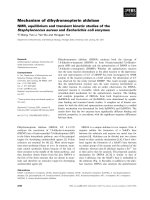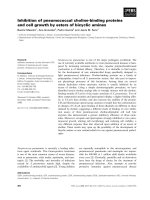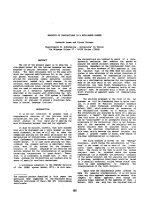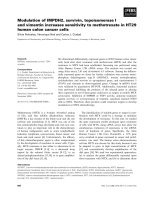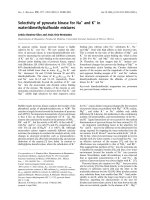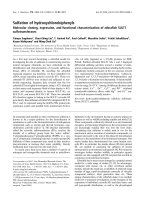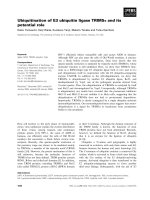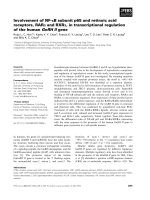Báo cáo khoa học: "Influence of organic versus inorganic dietary selenium supplementation on the concentration of selenium in colostrum, milk and blood of beef cows" pptx
Bạn đang xem bản rút gọn của tài liệu. Xem và tải ngay bản đầy đủ của tài liệu tại đây (245.87 KB, 6 trang )
BioMed Central
Page 1 of 6
(page number not for citation purposes)
Acta Veterinaria Scandinavica
Open Access
Research
Influence of organic versus inorganic dietary selenium
supplementation on the concentration of selenium in colostrum,
milk and blood of beef cows
Petr Slavik*
1
, Josef Illek
2
, Michal Brix
3
, Jaroslava Hlavicova
2
, Radko Rajmon
1
and Frantisek Jilek
1
Address:
1
Department of Veterinary Sciences, Czech University of Life Sciences Prague, Kamycka 129, Prague 6, CZ165 21, Czech Republic,
2
Clinic
of Ruminant Diseases, University of Veterinary and Pharmaceutical Sciences Brno, Palackeho 1/3 Brno, CZ612 42, Czech Republic and
3
Private
Veterinary Practice, Blumentalska 22, Bratislava, SK811 07, Slovakia
Email: Petr Slavik* - ; Josef Illek - ; Michal Brix - ;
Jaroslava Hlavicova - ; Radko Rajmon - ; Frantisek Jilek -
* Corresponding author
Abstract
Background: Selenium (Se) is important for the postnatal development of the calf. In the first weeks of life, milk
is the only source of Se for the calf and insufficient level of Se in the milk may lead to Se deficiency. Maternal Se
supplementation is used to prevent this.
We investigated the effect of dietary Se-enriched yeast (SY) or sodium selenite (SS) supplements on selected
blood parameters and on Se concentrations in the blood, colostrum, and milk of Se-deficient Charolais cows.
Methods: Cows in late pregnancy received a mineral premix with Se (SS or SY, 50 mg Se per kg premix) or
without Se (control – C). Supplementation was initiated 6 weeks before expected calving. Blood and colostrum
samples were taken from the cows that had just calved (Colostral period). Additional samples were taken around
2 weeks (milk) and 5 weeks (milk and blood) after calving corresponding to Se supplementation for 6 and 12
weeks, respectively (Lactation period) for Se, biochemical and haematological analyses.
Results: Colostral period. Se concentrations in whole blood and colostrum on day 1 post partum and in
colostrum on day 3 post partum were 93.0, 72.9, and 47.5 μg/L in the SY group; 68.0, 56.0 and 18.8 μg/L in the SS
group; and 35.1, 27.3 and 10.5 μg/L in the C group, respectively. Differences among all the groups were significant
(P < 0.01) at each sampling, just as the colostrum Se content decreases were from day 1 to day 3 in each group.
The relatively smallest decrease in colostrum Se concentration was found in the SY group (P < 0.01).
Lactation period. The mean Se concentrations in milk in weeks 6 and 12 of supplementation were 20.4 and 19.6
μg/L in the SY group, 8.3 and 11.9 μg/L in the SS group, and 6.9 and 6.6 μg/L in the C group, respectively. The
values only differed significantly in the SS group (P < 0.05). The Se concentrations in the blood were similar to
those of cows examined on the day of calving. The levels of glutathione peroxidase (GSH-Px) activity were 364.70,
283.82 and 187.46 μkat/L in the SY, SS, and C groups, respectively. This was the only significantly variable
biochemical and haematological parameter.
Conclusion: Se-enriched yeast was much more effective than sodium selenite in increasing the concentration of
Se in the blood, colostrum and milk, as well as the GSH-Px activity.
Published: 3 November 2008
Acta Veterinaria Scandinavica 2008, 50:43 doi:10.1186/1751-0147-50-43
Received: 2 April 2008
Accepted: 3 November 2008
This article is available from: />© 2008 Slavik et al; licensee BioMed Central Ltd.
This is an Open Access article distributed under the terms of the Creative Commons Attribution License ( />),
which permits unrestricted use, distribution, and reproduction in any medium, provided the original work is properly cited.
Acta Veterinaria Scandinavica 2008, 50:43 />Page 2 of 6
(page number not for citation purposes)
Background
Selenium (Se) is extremely important for the proper post-
natal development of the calf. Selenium deficiency com-
promises growth, health and fertility [1]. During
pregnancy, Se passes through the placental barrier, and
even if the cow is moderately Se deficient, the calf receives
a sufficient Se supply [2]. In the first weeks of life, milk is
the only source of Se for the calf, but the Se content in the
milk is rather low [3]. Therefore, calves from dams with
insufficient Se supplementation may suffer from myodys-
trophic diseases [4] or other disorders related to Se defi-
ciency.
It has been demonstrated that the Se content in colostrum
is higher than in milk [5,6], but the dynamics of the Se
concentration in colostrum and milk are unknown. Also,
very variable Se concentrations in colostrum or milk and
varying correlations between Se concentrations in blood
and milk have been observed [5-10]. Besides being due to
the nutritional level of Se, this may also reflect differences
in milk yield and cattle breed among the studies. Beef cat-
tle have been studied to a lesser extent than dairy cattle
although beef calves are generally more dependent on the
dams' milk than calves from dairy farms, which often
receive milk substitutes.
The Se content in body fluids depends considerably on
the Se intake from the diet. Dietary supplementation with
Se-enriched yeast (SY) results in higher concentrations of
Se in cows' milk than inorganic Se (SS) supplementation
does [11]. Replacing inorganic Se with organic Se has
been suggested as one way to increase Se intake in
humans in areas with suboptimal Se status [12]. Studies
performed mainly on dairy cattle have shown an increase
of Se concentration in the milk of animals supplemented
with SY as compared with those supplemented with SS.
The increase has ranged from 34% [9] to 90% [11].
Although Se is an essential mineral, the effects of Se sup-
plementation on haematological or biochemical parame-
ters are considered minimal in cattle without significant
Se deficiency [9,13]. Biochemical changes in Se deficient
cattle include changed activity of the enzymes aspartate
aminotransferase (AST), creatine kinase (CK), and glu-
tathione peroxidase (GSH-Px) [14]. Also, significant dif-
ferences in blood urea concentration have been observed
after Se treatment [9].
GSH-Px activity is considered to be an indicator of long-
term Se supply, as it depends on the erythrocyte life cycle
[14]. However, it has been discussed how rapidly the
GSH-Px activity reflects changes in the Se status. Also, the
relationship between GSH-Px activity and the Se form in
the diet (SS or SY) is not definite [15].
The objective of this study was to investigate 1) Se concen-
trations in colostrum and milk in a Se deficient beef cattle
herd, 2) the effect of feeding premixes supplemented with
SY or SS on Se concentrations in the blood, colostrum,
and milk and on the dynamics of the Se concentration,
and 3) the effect of providing different dietary Se sources
on selected blood biochemical parameters in Se deficient
animals.
Methods
Management, animals and feeding
The study was conducted in a Charolais herd in the Vys-
ocina region, Czech Republic. The herd included about
350 head of cattle of which 180 were reproductive. The
animals were located at several sites relatively close to
each other. The winter diet consisted of grass silage and
hay. Grazing was provided in early spring and late
autumn. The calving period lasted from March through
May.
Experimental design
The study lasted three consecutive months (starting in
March 2007) and included 120 late pregnant cows. There
were 3 experimental groups of 40 cows each. Two groups
(SY and SS) were fed the same mineral premix supple-
mented with 50 mg Se/kg premix. The SY group received
an organic Se source (Se-enriched yeast Sel-Plex 50, All-
tech, Nicholasville, KY) and the SS group received an inor-
ganic Se supplement (sodium selenite) while the control
group received a premix without Se supplementation. Se
supplementation was initiated 6 weeks before the
expected calving period.
All the cows received the same basic diet and had free
access to a micro-pellet mineral feed (Ca 12%, P 6%, Na
11%, Mg 13%, Cu 1500 mg/kg, Mn 2100 mg/kg, Zn 1100
mg/kg, I 100 mg/kg, Co 40 mg/kg, vitamin A 1000000
I.U./kg, vitamin D 100000 I.U./kg, vitamin E 1000 mg/
kg).
The Se status was determined at the beginning of the study
by analyzing whole blood of 20 randomly selected cows.
Different experimental set-ups were used in the 2 study
parts (colostrum and lactation periods, respectively).
Sampling during the colostrum period was done on the
day of calving and on day 3 post partum. As the cows calved
continuously, the preceding period of Se supplementa-
tion varied, but was never less than 6 weeks. Sampling
during the lactation period was done after a fixed period
of 6 and 12 weeks Se supplementation. The period from
calving to date of sampling varied because the time of Se
supplementation was fixed and the animals calved contin-
uously, but it was never less than 10 days. Data on indi-
vidual cows is shown in additional files 1 and 2
Acta Veterinaria Scandinavica 2008, 50:43 />Page 3 of 6
(page number not for citation purposes)
(Additional file 1: Individual data on cows analysed for
selenium content in colostrum; Additional file 2: Individ-
ual data on cows analysed for selenium content in milk).
The concentration of Se in the colostrum was determined
twice from 6 randomly selected cows from each of the 3
groups. Colostrum was sampled within 12 h post partum
and on day 3 post partum (colostral period). Also a blood
sample was taken in association with the first collection of
colostrum to determine blood Se level. The Se level in
milk and blood was determined twice during the lactation
period by random sampling of 6 cows from each group in
weeks 6 and 12 of the experiment, respectively (lactation
period). Blood samples were collected for biochemical
and haematological analysis in week 12 (see below).
Sampling
During the experimental period, six 250 g samples of grass
silage (47.49% dry matter (DM)), hay (88.95% DM), and
pasture fodder (22.2% DM) were collected and frozen at -
18°C. At the end of the study, feed samples were homog-
enized, mixed, and the mean Se content on the DM basis
was determined.
Blood samples were drawn from the coccygeal vein using
the HEMOS
®
system (1 lithium heparin, 1 K
3
EDTA, and 1
serum tube) (GAMA, Ceske Budejovice, Czech Republic).
Milk and colostrum samples were drawn between two calf
nursings using a sterile tube. The samples for Se analysis
were frozen at -18°C, and analyzed at the end of the
study.
Laboratory analyses
The concentrations of Se in whole blood, milk, and feed
were analyzed with hydride generation atomic absorption
spectrophotometry (HG-AAS) using the method
described by Sturman [16].
The blood was analyzed for urea and total protein content
and for the activity of CK and AST in the serum, and for
GSH-Px activity in whole blood.
Haematology included erythrocyte count, hemoglobin
content and total number of leukocytes. Standard tech-
niques were used for these analyses (Central Clinical Lab-
oratories, University of Veterinary and Pharmaceutical
Science, CZ). GSH-Px activity was determined by the
RANDOX-RANSEL RS 505 kit and the method described
by Paglia and Valentine [17].
Statistical analyses
The data were analyzed by ANOVA test and contrast tests
were subsequently used to compare the control group to
the other groups and the supplemented groups with each
other. One-way ANOVA was used for most of the param-
eters. The data on colostrum were also analyzed by
ANOVA for repeated measure design. For analysis of data
on the Se concentration in milk, multi-factorial (2-way)
ANOVA was used. The software package Statistica 8.0
(StatSoft, Inc.) was used. Differences were considered as
significant when P < 0.05.
Results and discussion
Analysis of feed
The mean daily intake for the period under study was 14
kg of DM per cow. Roughage consisted of grass silage
(0.033 mg Se/kg DM) and hay (0.051 mg Se/kg DM), in a
ratio of 1:2 on the DM basis. By the beginning of May, all
the cows had calved and were driven to pasture (0.084 mg
Se/kg DM). The mean daily intake of the mineral premix
was 70 g per head, i.e., 3.5 mg Se per head per day in the
supplemented groups. The estimated intake of Se natu-
rally present in the feed was 0.65 mg per head per day for
all groups.
Selenium status of the herd
The average whole blood Se content before experimental
Se supplementation was 38.5 μg/L (S.D. 8.4). The blood
Se concentration in the control animals remained at this
level throughout the study. All animals were considered to
be Se deficient at the beginning of the study and the con-
trol animals remained deficient throughout the study as
levels below 70 μg/L are subnormal [14].
Colostral period
The animals of the supplemented groups had significantly
higher blood Se concentrations at day 1 post partum than
the controls (P < 0.01) (Table 1). Furthermore, the SY
group had a higher Se level than the SS animals (P < 0.01).
These findings correspond to previously published results
[7,9]. Weiss [15] compared the results of 10 studies and
reported 18% as the median difference in Se concentra-
tions in the blood of animals given organic Se compared
to those given inorganic Se. In the present study, the dif-
Table 1: Mean selenium concentrations (μg/L) in whole blood
and colostrum of beef cows receiving selenium-enriched yeast
(SY), sodium selenite (SS) or no selenium supplementation (C):
Analyses performed on day 1 post partum (blood and colostrum)
and day 3 post partum (colostrum).
Group SY (N = 6) SS (N = 6) C (N = 6)
x S.D. x S.D. x S.D.
Blood 93.0
a
9.2 68.0
b
9.8 35.1
c
3.5
Colostrum Day 1 72.9
a1
7.5 56.0
b1
8.0 27.3
c1
2.7
Day 3 47.5
a2
8.8 18.8
b2
1.0 10.5
c2
1.2
abc
Values designated by different superscripts within a row differ at a
significance level of P < 0.05. (Repeated measure analysis for
colostrum values – P < 0.01).
1,2
Selenium concentration values designated by different superscripts
within a column differ at a significance level of P < 0.01.
Acta Veterinaria Scandinavica 2008, 50:43 />Page 4 of 6
(page number not for citation purposes)
ference observed was greater (36%). This may be
explained by breed differences (dairy vs. beef), that the
cows included in this study were Se deficient at the begin-
ning of the study, and/or that the dose of Se used was
higher than in other studies.
Despite a low blood Se concentration, a relatively high Se
content in colostrum just after calving was found in the
control group (27.3 μg/L) (Table 1). Interpretation of this
finding is difficult due to the lack of corresponding stud-
ies. Micetic-Turk et al. [6] found a similar level (29.9 μg/
L) in colostrum of dairy cattle, but with a corresponding
blood concentration of 62 μg/L. Our data are more similar
to those found in Belgian Blue cattle [18] showing a very
close correlation between colostral and estimated whole
blood Se content. It is possible that Se concentrations in
colostrum are higher in beef breeds than in dairy breeds
due to a lower colostrum production. Similar findings
have been made in sheep [19], swine [20], and humans
[21], which also produce colostrum in relatively small
volumes.
Both the supplemented groups showed higher mean
colostrum Se concentrations than the control with the SY
group being the highest (Table 1). These findings corre-
spond to previous observations [10,18]. The colostrum Se
concentration remains higher even if the animals are
given a diet with a twice as high inorganic Se content as
organic Se [10].
The colostral Se concentration was significantly reduced
on day 3 post partum for all groups (Table 1). In the control
group, Se concentration dropped to nearly the level
present in milk later in the study period (Table 2). In the
SY group, however, the colostrum Se concentration on
day 3 post partum was only 35% lower than that measured
just after calving, whereas the SS and control groups
showed a 67% and 62% decrease, respectively. The higher
Se concentration in the SY group may reflect a higher bio-
availability of organic Se. It is possible, that the decrease
of Se concentration in all groups is associated with a
decreased colostral protein content reflecting the conver-
sion of colostrum into milk as most Se in milk is bound
in complexes with proteins [22]. The high Se concentra-
tion may also reflect an active transport of Se into the
colostrum.
The Se content in colostrum of individual cows is shown
in additional file 1 (Individual data on cows analysed for
selenium content in colostrum).
Lactation period
The blood Se concentrations found at weeks 6 or 12 of Se
supplementation (Table 2) did not differ from the values
found during the colostral period. Analyses of milk Se
concentrations did not demonstrate differences between
the 2 sampling periods for the SY and control groups,
while the Se level increased significantly for the SS group
(Table 2). This finding does not correspond to the find-
ings made by Ortman and Pehrson [3], who demon-
strated stable Se levels in the milk one week after
supplementation with SS. However, the discrepancy
might be explained by a more appropriate Se status at the
start of their experiment (90 μg Se/L blood).
The milk Se concentration differed significantly among
the groups for both weeks 6 and 12 with the SY group hav-
ing the highest level, the SS group having an intermediate
concentration and the control group having the lowest
values (Table 2). Similar finding have been found in other
studies as reviewed by Weiss [15]. However the difference
between the SY and SS groups was rather great. The rela-
tive increase in milk Se concentration (compared to the
control) was 2.45 and 1.65 times higher in the SY group
than in the SS group in weeks 6 and 12, respectively.
The milk Se values of the supplemented groups were
rather low compared to those found in other studies [3,9].
However, these studies also showed substantially higher
Se content in cows' blood (>100 μg/L). On the other
hand, Pehrson et al. [7] found very similar milk Se concen-
trations (SS 12.7 μg/L; SY 17.25 μg/L) but with high Se
blood levels (around 125 μg/L). The cause of these dis-
crepancies is not clear.
Data on the Se content in milk of individual animals is
shown in additional file 2 (Individual data on cows ana-
lysed for selenium content in milk).
Blood chemistry and haematology (Lactation period)
The biochemical and haematological parameters were not
affected by the Se supplementation except for blood urea
Table 2: Mean concentrations of selenium (μg/L) in whole blood
and milk of beef cows receiving selenium-enriched yeast (SY),
sodium selenite (SS) or no selenium supplementation (C):
Analyses performed in weeks 6 and 12 of selenium
supplementation.
Group SY SS C
x S.D. x S.D. X S.D.
Week 6 (N = 6) Blood 89.6
a
9.1 63.6
b
7.2 44.4
c
4.4
Milk 20.4
a
2.1 8.3
b1
1.2 6.9
c
1.0
Week 12 (N = 6) Blood 88.6
a
14.9 65.0
b
9.5 42.4
c
11.2
Milk 19.6
a
1.2 11.9
b2
2.2 6.6
c
1.0
abc
Values designated by different superscripts within a row differ at a
significance level of P < 0.01.
1,2
Milk selenium concentration values designated by different
superscripts within a column differ at a significance level of P < 0.05
Acta Veterinaria Scandinavica 2008, 50:43 />Page 5 of 6
(page number not for citation purposes)
and GSH-Px (Table 3). The SS group showed an increase
in the blood urea level. Different blood urea values
between animals supplemented with different Se sources
has been reported previously [9], but the findings are con-
tradictory. The findings are not considered to be of biolog-
ical significance.
Significant differences in GSH-Px activity were found
among all the groups. The SY group showed the highest
activity, the SS group an intermediate activity and the con-
trol group had the lowest activity (Table 3). However,
despite having received Se supplementation for 12 weeks,
none of the groups had GSH-Px activity above the mini-
mal reference value (600 μkat/L) [14]. This is surprising
since the Se levels in the blood had reached normal levels
weeks before, at least for the SY group (Tables 1 and 2).
The relationship between Se saturation and GSH-Px activ-
ity has recently been discussed [13]. It is possible that
incorporation of Se into the erythrocyte GSH-Px was
delayed by the previous Se deficiency thus causing the
reduced GSH-Px activity.
The significant difference between the SY and SS groups is
partially inconsistent with previous findings as reviewed
by Weiss [15], who compared more than 10 studies on
this subject. In eight studies, no significant differences in
the GSH-Px activity were found in animals supplemented
with either organic or inorganic Se. The findings in the
present study might be associated with the initial Se defi-
ciency and a more efficient utilization of organic Se.
Conclusion
Selenium-enriched yeast was much more effective than
sodium selenite in increasing the concentration of Se in
blood, colostrum and milk, as well as the GSH-Px activity.
Cows fed selenium-enriched yeast also showed a slower
decrease in colostral Se levels. The findings indicate a
higher bioavailability of organic Se. This is possibly more
pronounced when treating Se deficient animals. As milk is
the only nutritional source of neonatal calves and later a
supplementary source of nutrition, the use of organic Se
may be of clinical significance.
Competing interests
The author(s) declare that they have no competing inter-
ests.
Authors' contributions
PS, MB and JH carried out the clinical trial and collected
samples of blood, colostrum and milk. JI participated in
the design of the study, supervised and participated in
data collection. RR carried out the statistical analysis. PS
wrote the manuscript. FJ coordinated the work. All the
authors have read and approved the final manuscript.
Additional material
Additional file 1
Individual data on cows analysed for selenium (Se) content in colostrum.
SY: Cows receiving organic dietary Se supplementation, SS: Cows receiv-
ing inorganic dietary Se supplementation and C: Cows not receiving addi-
tional Se.
Click here for file
[ />0147-50-43-S1.doc]
Table 3: Mean values of blood chemistry and haematology for beef cows receiving selenium-enriched yeast (SY), sodium selenite (SS)
or no selenium supplementation (C) for 12 weeks.
Group
SY SS C SEM
1
Analysis
Red blood cells, × 10
12
/L 7.15 6.3 6.03 0.58
White blood cells, × 10
9
/L 7.28 6.47 7.60 0.58
Haemoglobin, g/L 102.0 102.5 99.8 1.43
Total proteins, g/L 68.0 83.2 76.8 7.63
Urea mmol/L 3.20
b
5.71
a
3.88
b
1.29
Creatine kinase, μkat/L 4.39 4.14 4.77 0.72
Aspartate aminotransferase, μkat/L 1.61 1.58 1.66 0.04
Glutathione peroxidase μkat/L* 364.70
a
283.82
b
187.46
c
88.73
1
Standard error of the mean of 18 cows. 17 degrees of freedom.
abc
Statistically significant differences (P < 0.05) of urea concentration and glutathione peroxidase activity in SY, SS and C in the same row are
designated by different superscripts.
* Glutathione peroxidase activity values were determined in heparinized whole blood
Publish with BioMed Central and every
scientist can read your work free of charge
"BioMed Central will be the most significant development for
disseminating the results of biomedical research in our lifetime."
Sir Paul Nurse, Cancer Research UK
Your research papers will be:
available free of charge to the entire biomedical community
peer reviewed and published immediately upon acceptance
cited in PubMed and archived on PubMed Central
yours — you keep the copyright
Submit your manuscript here:
/>BioMedcentral
Acta Veterinaria Scandinavica 2008, 50:43 />Page 6 of 6
(page number not for citation purposes)
Acknowledgements
This study was supported by grants NAZV-QF 4005, NAZV-1G46086, and
MSM 6046070901. The authors thank Mrs. Lois Russell for her editorial
assistance with this manuscript.
References
1. Schwartz K, Foltz CM: Selenium as an integral part of factor 3
against dietary necrotic liver degeneration. J Am Chem Soc
1957, 79:3292-3293.
2. Gunter SA, Beck PA, Phillips JM: Effects of supplementary sele-
nium source on the performance and blood measurements
in beef cows and their calves. J Anim Sci 2003, 81:856-864.
3. Ortman K, Pehrson B: Effect of selenate as a feed supplement
to dairy cows in comparison to selenite and selenium yeast.
J Anim Sci 1999, 77:3365-3370.
4. Muth OH, Oldfield JE, Remmert RF, Schuber JR: Effect of selenium
and vitamin E on white muscle disease. Science (Wash., DC)
1958, 128:1090-1091.
5. Pavlata L, Pechova A, Dvorak R: Microelements in colostrum and
blood of cows and their calves during colostral nutrition. Acta
Vet Brno 2004, 73:421-429.
6. Micetic-Turk D, Rossipal E, Kracher M, Li F: Maternal selenium
status in Slovenia and its impact on the selenium concentra-
tion of umbilical cord serum and colostrum. Eur J Clin Nutr
2000, 54:522-524.
7. Pehrson B, Ortman K, Madjid N, Trafikowska U: The influence of
dietary selenium yeast or sodium selenite on the concentra-
tion of selenium in the milk of suckler cows and on the sele-
nium status of their calves. J Anim Sci 1999, 77:3371-3376.
8. Dobrzanski Z, Gorecka H, Opalinski S, Chojnacka K, Kolacz P: Trace
and ultra trace elements in cow's milk and blood [in Polish].
Medycyna Wetwrynaryja 2005, 61:301-304.
9. Juniper DT, Phipps RH, Jones AK, Bertin G: Selenium supplemen-
tation of lactating dairy cows: Effect on Selenium concentra-
tion in blood, milk, urine, and feces. J Dairy Sci 2006,
89:3544-3551.
10. Awadeh FT, Kincaid RL, Johnson KA: Effect of level and source of
dietary selenium on concentrations of thyroid hormones and
immunoglobulins in beef cows and calves. J Anim Sci 1998,
76(4):1204-1215.
11. Ortman K, Pehrson B: Selenite and selenium yeast as feed sup-
plements for dairy cows. Zentralbl Veterinarmed A
1997,
44(6):373-380.
12. Pehrson B: Organic selenium for supplementation on farm
animal diets: it's influence on the selenium status of the ani-
mals and on the dietary selenium intake of man. In Re-defining
Mineral Nutrition Edited by: Taylor-Pickard JA, Tucker LA. Notting-
ham, Nottingham University Press; 2005:253-267.
13. Juniper DT, Phipps RH, Givens DI, Jones AK, Green C, Bertin G: Tol-
erance of ruminant animals to high dose in-feed administra-
tion of a selenium-enriched yeast. J Anim Sci 2008, 86:197-204.
14. Pavlata L, Pechova A, Illek J: Direct and indirect assessment of
selenium status in cattle – a comparison. Acta Vet Brno 2000,
69:281-287.
15. Weiss WP: Selenium nutrition of dairy cows: Comparing
responses to organic and inorganic selenium forms. In Pro-
ceeding of the 19th Alltech Annual Symposium Nutrition, Biotechnology
Feed Food: 20–23 April 2003; Lexington Nottingham University Press,
Nottingham, UK; 2003:333-373.
16. Sturman BT: Development of a continuous-flow hydride and
mercury vapour generation accessory for atomic absorption
spectrophotometry. Appl Spectrosc 1985, 39:48-56.
17. Paglia DE, Valentine WN: Studies on the quantitative and qual-
itative characterization of erythrocyte glutathione peroxi-
dase. J Lab Clin Med 1967, 70:158-169.
18. Guyot H, Spring P, Andrieu S, Rollin F: Comparative responses to
sodium selenite and organic selenium supplements in Bel-
gian Blue cows and calves. Livest Sci 2007, 111:259-263.
19. Gabryszuk M, Czauderna M, Gralak MA, Antoszkiewicz Z: Effect of
pre- and postpartum injections of Se, Zn and vitamin E on
their concentration in ewes milk. J Anim Feed Sci 2005,
14:255-258.
20. Mahan DC: Effect of organic and inorganic selenium sources
and levels on sow colostrum and milk selenium content. J
Anim Sci 2000, 78(1):100-105.
21. Hannan MA, Dogadkin NN, Ashur IA, Markus WM: Copper, sele-
nium, and zinc concentrations in human milk during the first
three weeks of lactation. Biol Trace Elem Res 2005, 107:11-20.
22. Debski B, Picciano MF, Milner JA: Selenium content and distribu-
tion of human, cow and goat milk. J Nutr 1987, 117:1091-1097.
Additional file 2
Individual data on cows analysed for selenium (Se) content in milk. • SY:
Cows receiving organic dietary Se supplementation, SS: Cows receiving
inorganic dietary Se supplementation and C: Cows not receiving addi-
tional Se.
Click here for file
[ />0147-50-43-S2.doc]
